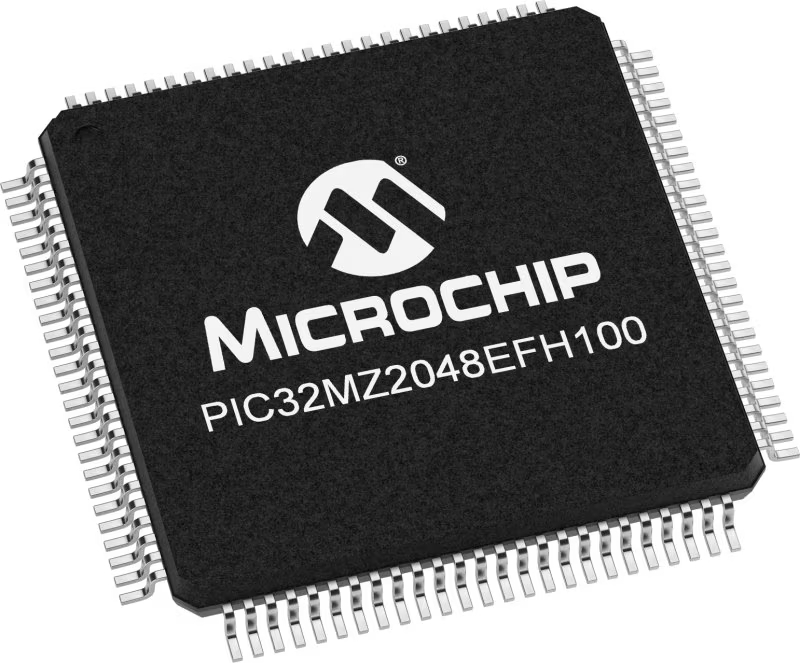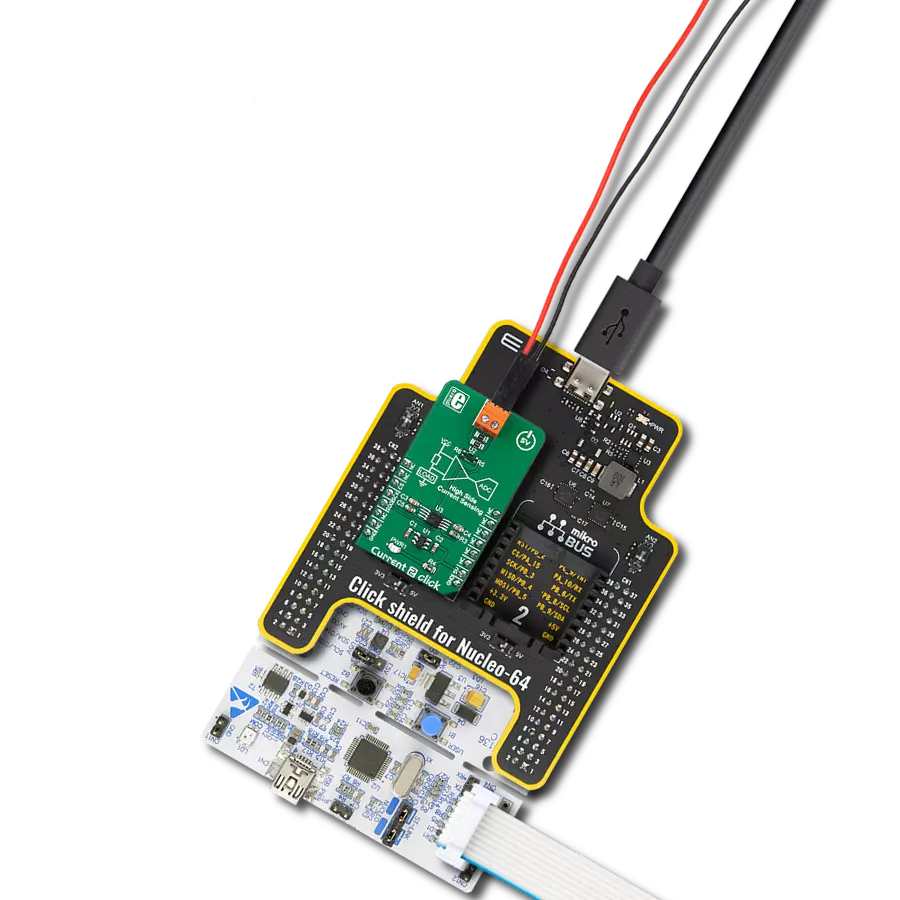Step into the future of current measurement with confidence. Our Hall Effect-based solution delivers not just data but a precise understanding of AC/DC currents, ensuring your systems operate at peak efficiency.
A
A
Hardware Overview
How does it work?
Hall Current 16 Click is based on the ACS37002, a 400kHz high-accuracy current sensor from Allegro Microsystems. It is a fully integrated Hall-effect current sensor, factory-trimmed to provide high accuracy over the entire operating range without user programming. The current is sensed differentially by two Hall plates that subtract out interfering external common mode magnetic fields. The Hall sensor has no physical connection to the integrated current conductor, as the ACS37002 provides high isolation by magnetically coupling the field generated by the current in the conductor. The current sensor features overvoltage detection, overcurrent fault, temperature compensation, and more. The ACS37002 is rated to withstand 3125VRMS of dielectric voltage. The IP+ and IP-
terminals are fused internally and allow connecting the load over the load connectors. Depending on the position of the two GAIN SEL jumpers, the gain can be set as high as 66.7A for IP as a maximum. By default, the gain is set to 0 position on both jumpers, which results in a 50A bidirectional gain. The sensitivity can range from 19.8 to 39.6mV/A depending on the chosen gain. The current sensor on the Hall Current 16 Click sends its output along with the zero current voltage reference to the ADC122S101, a two-channel 12-bit A/D converter from Texas Instruments. This ADC is fully specified over a sample rate range of 500ksps to 1Msps. It is based on a successive/approximation register architecture with an internal track-an-hold circuit. Hall Current 16 Click uses a standard 4-Wire SPI
serial interface of the ADC122S101 to communicate with the host MCU. If the sensed current exceeds the comparator threshold, the overcurrent fault (OCF) pin will trigger with an active LOW flag. The threshold can be set in percentage of full-scale output swing. You can turn off the overcurrent fault functionality. This Click board™ can operate with either 3.3V or 5V logic voltage levels selected via the PWR SEL jumper. This way, both 3.3V and 5V capable MCUs can use the communication lines properly. Also, this Click board™ comes equipped with a library containing easy-to-use functions and an example code that can be used as a reference for further development.

Features overview
Development board
Flip&Click PIC32MZ is a compact development board designed as a complete solution that brings the flexibility of add-on Click boards™ to your favorite microcontroller, making it a perfect starter kit for implementing your ideas. It comes with an onboard 32-bit PIC32MZ microcontroller, the PIC32MZ2048EFH100 from Microchip, four mikroBUS™ sockets for Click board™ connectivity, two USB connectors, LED indicators, buttons, debugger/programmer connectors, and two headers compatible with Arduino-UNO pinout. Thanks to innovative manufacturing technology,
it allows you to build gadgets with unique functionalities and features quickly. Each part of the Flip&Click PIC32MZ development kit contains the components necessary for the most efficient operation of the same board. In addition, there is the possibility of choosing the Flip&Click PIC32MZ programming method, using the chipKIT bootloader (Arduino-style development environment) or our USB HID bootloader using mikroC, mikroBasic, and mikroPascal for PIC32. This kit includes a clean and regulated power supply block through the USB Type-C (USB-C) connector. All communication
methods that mikroBUS™ itself supports are on this board, including the well-established mikroBUS™ socket, user-configurable buttons, and LED indicators. Flip&Click PIC32MZ development kit allows you to create a new application in minutes. Natively supported by Mikroe software tools, it covers many aspects of prototyping thanks to a considerable number of different Click boards™ (over a thousand boards), the number of which is growing every day.
Microcontroller Overview
MCU Card / MCU

Architecture
PIC32
MCU Memory (KB)
2048
Silicon Vendor
Microchip
Pin count
100
RAM (Bytes)
524288
Used MCU Pins
mikroBUS™ mapper
Take a closer look
Click board™ Schematic

Step by step
Project assembly
Track your results in real time
Application Output
1. Application Output - In Debug mode, the 'Application Output' window enables real-time data monitoring, offering direct insight into execution results. Ensure proper data display by configuring the environment correctly using the provided tutorial.

2. UART Terminal - Use the UART Terminal to monitor data transmission via a USB to UART converter, allowing direct communication between the Click board™ and your development system. Configure the baud rate and other serial settings according to your project's requirements to ensure proper functionality. For step-by-step setup instructions, refer to the provided tutorial.

3. Plot Output - The Plot feature offers a powerful way to visualize real-time sensor data, enabling trend analysis, debugging, and comparison of multiple data points. To set it up correctly, follow the provided tutorial, which includes a step-by-step example of using the Plot feature to display Click board™ readings. To use the Plot feature in your code, use the function: plot(*insert_graph_name*, variable_name);. This is a general format, and it is up to the user to replace 'insert_graph_name' with the actual graph name and 'variable_name' with the parameter to be displayed.

Software Support
Library Description
This library contains API for Hall Current 16 Click driver.
Key functions:
hallcurrent16_get_current- Hall Current 16 get current function.hallcurrent16_get_voltage- Hall Current 16 get voltage function.hallcurrent16_get_ovc_fault- Hall Current 16 get overcurrent fault function.
Open Source
Code example
The complete application code and a ready-to-use project are available through the NECTO Studio Package Manager for direct installation in the NECTO Studio. The application code can also be found on the MIKROE GitHub account.
/*!
* @file main.c
* @brief Hall Current 16 Click example
*
* # Description
* This example demonstrates the use of Hall Current 16 Click board
* by reading and displaying the current measurements.
*
* The demo application is composed of two sections :
*
* ## Application Init
* The initialization of SPI module and log UART.
* After driver initialization, the app sets the default configuration.
*
* ## Application Task
* The app reads the current measurements [A] and displays the results.
* Results are being sent to the UART Terminal, where you can track their changes.
*
* @author Nenad Filipovic
*
*/
#include "board.h"
#include "log.h"
#include "hallcurrent16.h"
static hallcurrent16_t hallcurrent16;
static log_t logger;
void application_init ( void )
{
log_cfg_t log_cfg; /**< Logger config object. */
hallcurrent16_cfg_t hallcurrent16_cfg; /**< Click config object. */
/**
* Logger initialization.
* Default baud rate: 115200
* Default log level: LOG_LEVEL_DEBUG
* @note If USB_UART_RX and USB_UART_TX
* are defined as HAL_PIN_NC, you will
* need to define them manually for log to work.
* See @b LOG_MAP_USB_UART macro definition for detailed explanation.
*/
LOG_MAP_USB_UART( log_cfg );
log_init( &logger, &log_cfg );
log_info( &logger, " Application Init " );
// Click initialization.
hallcurrent16_cfg_setup( &hallcurrent16_cfg );
HALLCURRENT16_MAP_MIKROBUS( hallcurrent16_cfg, MIKROBUS_1 );
if ( SPI_MASTER_ERROR == hallcurrent16_init( &hallcurrent16, &hallcurrent16_cfg ) )
{
log_error( &logger, " Communication init." );
for ( ; ; );
}
Delay_ms ( 100 );
if ( HALLCURRENT16_ERROR == hallcurrent16_default_cfg ( &hallcurrent16 ) )
{
log_error( &logger, " Default configuration." );
for ( ; ; );
}
log_info( &logger, " Application Task " );
log_printf( &logger, " -------------------- \r\n" );
Delay_ms ( 100 );
}
void application_task ( void )
{
static float current = 0.0;
if ( HALLCURRENT16_OK == hallcurrent16_get_current( &hallcurrent16, ¤t ) )
{
log_printf( &logger, " Current : %.3f A \r\n", current );
}
log_printf( &logger, " -------------------- \r\n" );
Delay_ms ( 1000 );
}
int main ( void )
{
/* Do not remove this line or clock might not be set correctly. */
#ifdef PREINIT_SUPPORTED
preinit();
#endif
application_init( );
for ( ; ; )
{
application_task( );
}
return 0;
}
// ------------------------------------------------------------------------ END

































